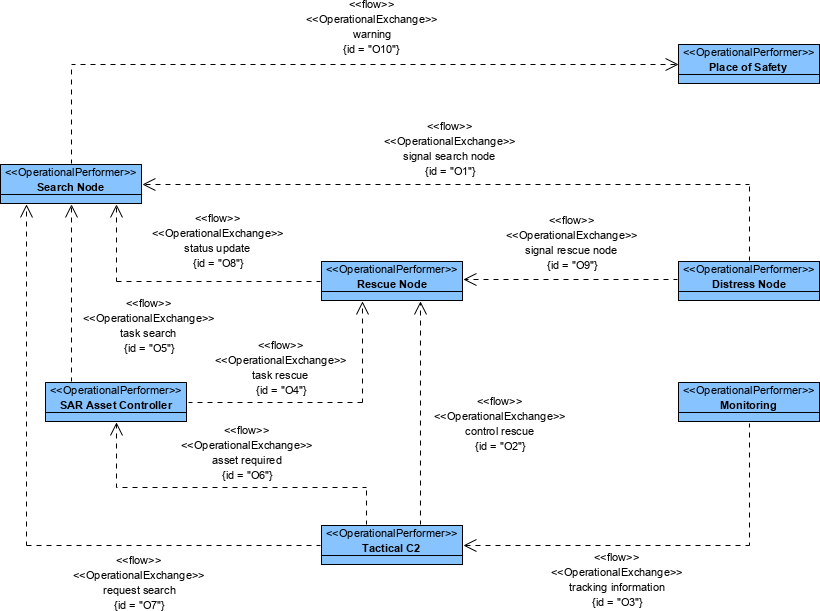The OV-2 shows, at a high level, the interactions between logical nodes and depicts the capabilities that those nodes bring to the architecture.
The primary purpose of the OV-2 is to specify nodes (elements of capability) in context with each other. The context is usually expressed in terms of the information that flows between the nodes (e.g. the information flow requirements between capabilities in a given scenario). However, the context may also be flows of materiel, human resource or energy.
Usage
The intended usage of the OV-2 includes:
- Definition of operational concepts.
- Elaboration of capability requirements.
- Definition of collaboration needs.
- Associating capability with a location.
- Problem space definition.
- Operational planning.
- Supply chain analysis.
- Security models – e.g. domain-based security and entity trust models.
Product Description
The OV-2 depicts nodes and the needlines between them, primarily to indicate a need to exchange or share information. The OV-2 may, however, also show the location (or type of location or environment) of nodes, and may optionally be annotated to show flows of people, materiel or energy between nodes.
The primary purpose of an OV-2 is to define the logical structure of architecture. Building on the strategic intent identified in StV-1, Enterprise Vision, OV-2 takes the required capabilities and expresses them as nodes which interact by exchanging information or producing / consuming services.
The nodes in the logical architecture do not represent specific organisations, systems or locations. This enables Information Exchange Requirements (IERs) to be established without prescribing the way that the information exchange is handled. OV-2 does not, therefore, depict the physical connectivity between the nodes. An OV-2 can be a powerful way of expressing the differences between an as-is architecture and a proposed architecture to non-technical stakeholders, as it can be used to emphasise how information flows (or does not flow) without becoming over-complex.
Note that there are two diagrams available. The nodes (i.e. Operational Performers) and the needlines between them can be represented with Operational Node Relationship Description diagram, while the structure of each node can be modeled using the Operational Node Internal Relationship Description diagram.
Creating an Operational Node Relationship Description (diagram)
To create an Operational Node Relationship Description:
- Click on Operational Node Relationship Description in the Action Artifact area, and then select Create New Diagram.
- Type the diagram name and press Enter.
- A blank diagram is created and you can start constructing the view. Create OperationalPerformers.
- Draw the information flows between OperationalPerformers by creating OperationalExchanges between them.
Creating an Operational Node Internal Relationship Description (diagram)
To create an Operational Node Internal Relationship Description:
- Click on Operational Node Internal Relationship Description in the Action Artifact area, and then select Create New Diagram.
- Type the diagram name and press Enter.
- A blank diagram is created and you can start constructing the view. Reuse OperationalPerformers (recommended) through dragging and dropping them from the Model Explorer.
- Create OperationalConnectors between OperationalRoles. If OperationalRoles weren’t yet defined yet, you can create them in this view.

MODAF in Visual Paradigm
The MODAF is brought to you by Visual Paradigm, a full-featured development platform. Visual Paradigm provides an easy-to-use, model-driven MODAF tool that supports the development of MODAF views and models. You can create integrated MODAF products and generate architectural documents that facilitate organizations to efficiently coordinate enterprise architecture initiatives.